|
HAWKSBILL HATCHING |
Hawksbill sea turtles are a critically endangered species. A
precious few of the females choose Maui to lay their nests. One such is
Orion. Orion has visited Maui off and on over the years and has had a
history of successful nests. This is the story of the fourth nest she laid
on the world-class Makena Beach, aka Big Beach in 2004.
Orion later completed her last of five nests on Maui and took a victory
lap around Molokini, with stops on Kaho’olawe and West Maui, and then back past
the nests on Big Beach. She headed north between Maui and the Big Island,
then northwest. Fortunately she’d been fitted with a monitoring device so
her extended journey was tracked nearly to Kauai. Her Maui nests were left
to those who care.
Unfortunately, Orion was not observed making her fourth nest, so its
precise location was not known. Her monitor showed where she had hauled
out and tracks showed the approximate location. The area was nice, clean
sand, about 125’ from the ocean.
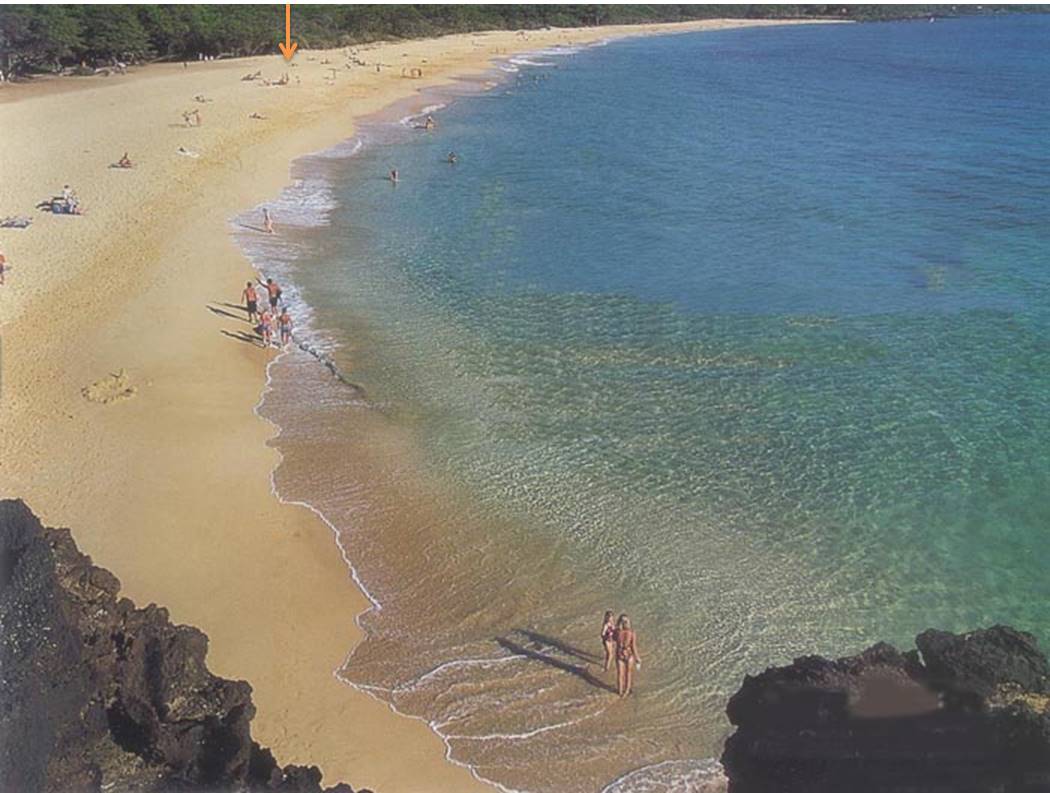
This is Makena Beach in South Maui. The point of the arrow marks the
approximate location of Orion’s 4th 2004 nest.
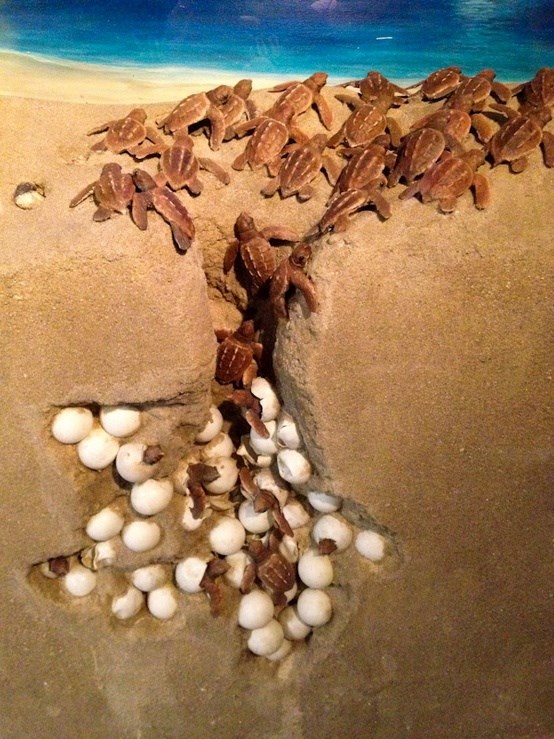
This is an artist’s conception of a typical sea turtle nest at the time of
hatching.
On October 14th, 59 days after Orion’s work, a crew of volunteers stayed
all night with this nest. Our job was to inspect the area regularly to see
if the nest reveals itself with activity and then be ready to protect the
hatchlings in their trek to the ocean.
Just as dawn was breaking on the 15th a cone shaped depression formed
about 8” around and 4” deep, finally revealing the location of the nest. A
secondary hole about 4” by 2” overlapped the larger hole. At about 5
minute intervals low levels of activity could be seen. This went on for
what seemed like forever. The sun popped out over Mt. Haleakala and
concern grew. Daylight brings out mobs of beach visitors and predators,
and the risk of overheating.
Judy called Cheryl the turtle lady for instructions. Cheryl said that a daytime crew would soon be there and that she would come by as soon as she could.
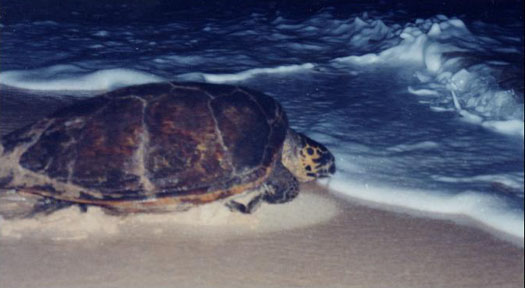
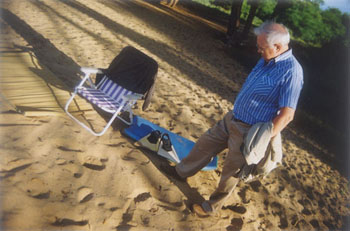
Orion, Hawksbill Sea Turtle Extraordinaire
Hole below the V of the left chair leg
The five-minute activity “surges” continued. The first of the day
crew showed up. Finally a head popped up in the smaller of the two cones.
The eyes were totally obscured with caked sand and the head was very still.
The next surge revealed shoulders and front flippers but no apparent enthusiasm
to get moving. The body was oriented vertically. One more surge and
the body was clear of sand and mostly horizontal, but the hatchling seemed
lethargic.
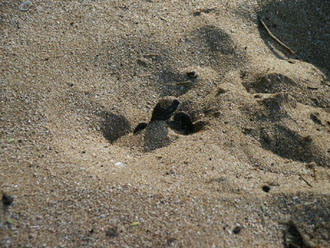
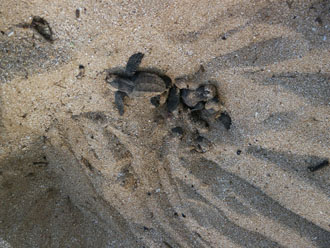
By this time, just a very few humans were on Big Beach, only one group
nearby. Mirna took a break from smoothing a track from the nest to the
ocean, went over to the couple with a small child and invited them to observe.
The boy and his mother came over to the nest and the father went in the water
with a camera.
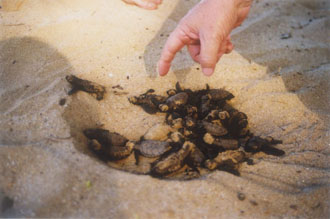
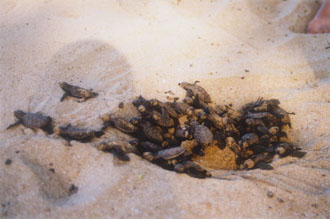
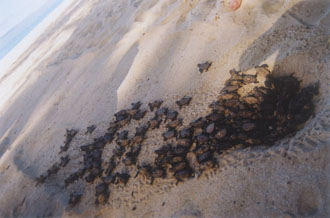
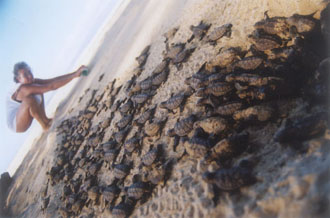
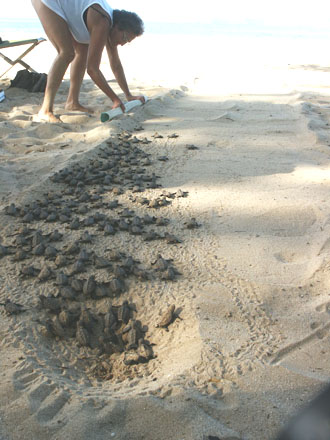
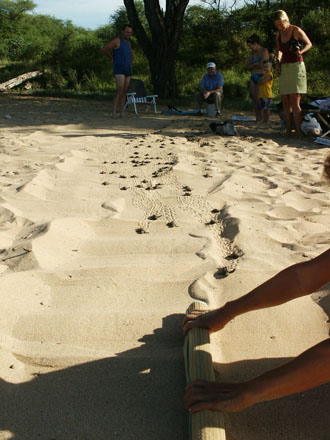
There they go…
…here they come
About 180 hatchlings came out of the nest, made it to the water and of
course disappeared to our view. Once the first group of ten came out, it
was all over within about 15 minutes. No land predators, humans, or
obstacles made claims. Inspection of the tracks shows that not one went in
a wrong direction. The “fan” of tracks started at 1’ wide at the nest and
expanded to only about 20’ wide at the water. Wave action spread the
hatchlings over about 150’ before they all got into the water.
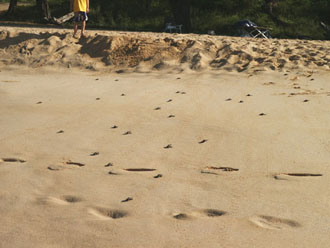
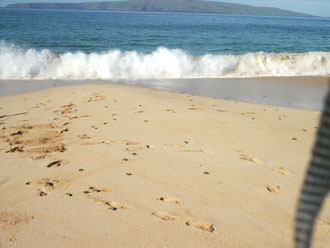
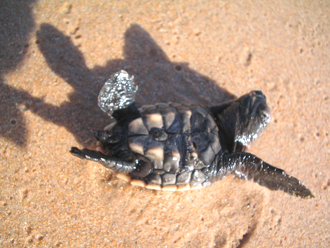
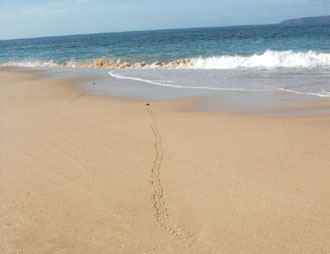
Tumbles in the waves caused temporary delays but upon stabilizing the trek
resumed.
Orion was no longer concerned, but with her excellent work on this nest
and the protection of caring volunteers and naturalists, perhaps some small
number of these new hawksbills will survive, mature, and come back to Maui nei
in a few years to help pull the hawksbill turtle back from its endangered
status.
That young man who observed this miracle has no idea how privileged he
was, but the other handful of us who witnessed it feel deep gratitude.
Orion was the only hawksbill known to have nested on Maui in 2004.
She left five nests with varying degrees of success. She was fitted with a
transmitter as she worked on an early nest, so her activity on this nest was
electronically detected. A few “props” were left around the general area
making it look occupied, hopefully to keep beach visitors from walking on the
nest.
Starting on day 58 and extending for an optimistic five days, Cheryl
developed a duty roster of volunteers to watch over the nest. A bunch of
people showed up early evening on day 59 in the hopes of seeing action, but they
thinned out one by one, leaving Eric, Judy and Pono for the long haul.
Next morning, Mirna was the first dayshift to show up. These four, the boy
and his mother were the lucky witnesses. Lots of people showed up after
the event to marvel at the fan of tracks and to hear the story told again and
again by those who saw it.
Mahalo, Orion – a hui hou!
The rest of the story:
Friday night Tom and Jan sat with the nest. Two single hatchlings came out some 8 hours apart and made it safely to the water.
Sunday evening Skippy and Glynis, aided by Cheryl, excavated the nest.
They found three more hatchlings and just a few undeveloped eggs. They
took samples of the sand on the top and bottom of the nest, counted and saved
the shells, measured the hatchlings and the nest, took a GPS reading of the nest
and an accurate measurement from the nest to the water.
Orion produced about 190 eggs in nest 4 of which 185 hatched and made it
to the ocean. This was the most productive of her five nests on Maui in
2004.
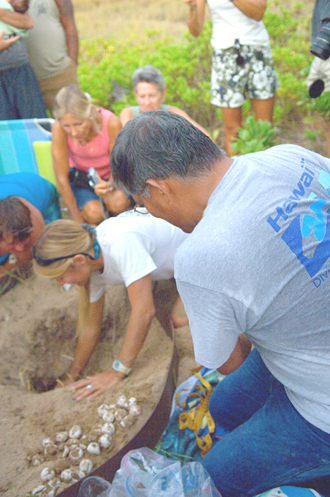
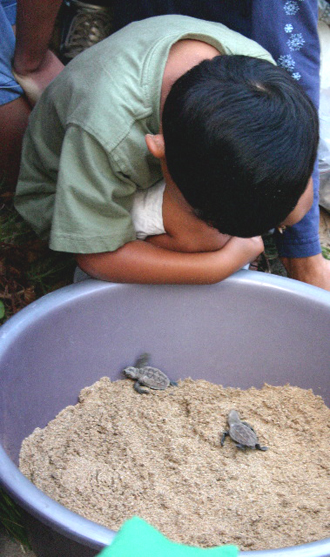
Skippy and Cheryl excavate the nest…
…and find a few more hatchlings
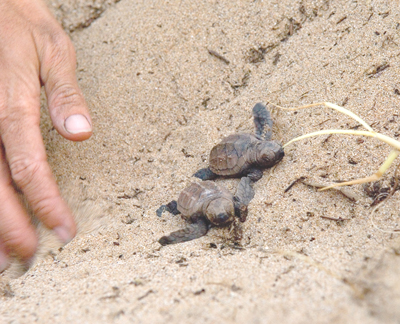
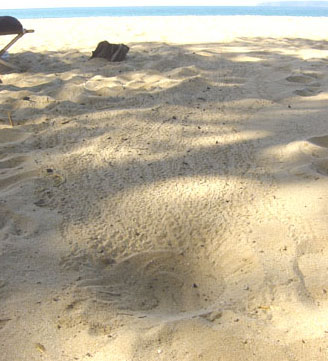
Which are measured and
released…
…leaving nothing but memories
AFTERWORD
The excavation pictures were from Orion’s fifth nest, but the nest
post-processing is always pretty much the same. Excavation observers get a
close-up of any leftover hatchlings and see the nest being disassembled.
|
|
|
|
|
|
|
|